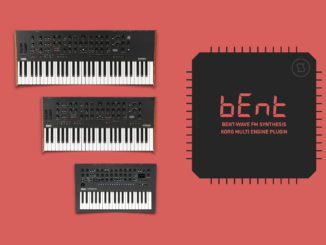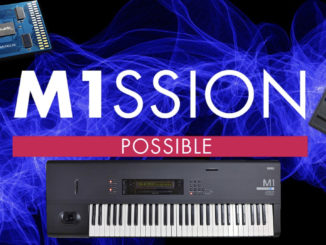Korg celebrated NAMM 2024 with a true product news storm (PS-3300 FS, KingKorg Neo…), but what remains?
Day 1 after NAMM 2024. Many manufacturers have dismantled their booths or have already left the building. NAMM was once again very weak in the Synthesizer sector, especially in the Eurorack area. If 4MS, Morphor… hadn’t been there, Eurorack wouldn’t have been a topic at NAMM 2024 at all.
The company that generated the most synth news in the Anaheim hallways was Korg, with their news storm. The rebirth of the epic PS-3300 FS, some digital comebacks… After the initial hype has passed, let’s now take a sober look at the whole Korg at NAMM 2024 show.
Korg NAMM 2024
Korg dominated the event with their news. Without them, NAMM would almost have been a synth news-free event. But thank god the storm of new gear came. The Tokyo-based company has introduced nine new products in the last two weeks, without naming the new mixers, and more. Crazy!
Digital Is The New Analog
A point you can note from NAMM 2024. Where analog was the big topic a few years ago, this “KorgNAMM” booth was floated with more digital synths than in a long time. No wonder digital technology has made a big leap forward in recent years.
There is a lot more digital power, but there isn’t much innovation. It’s more like recycling old synth concepts. See the new KingKorg Neo and the microKORG 2.
KingKORG Neo
It’s basically the same synth from 2013, with a few new waveforms + PCM samples, newly developed effects, remade looks, and interface. Plus, a gooseneck mic and a key downgrade. More precisely, fewer keys in a wobbly-quality keybed, found on the wavestate, opsix, and modwave.
Mmmh, there are 11 years between the devices; I don’t see the mega technical progress. It’s the same for the sound. It sounds like a great VA synth, but it doesn’t blow me away either. At €1099, it’s anything but cheap; the golden KingKORG is available used for €500-600 and could be the better deal.
In addition to the KingKORG Neo, the successor to the best-seller MicroKorg, which goes by the simple name microKORG 2, was also announced.
microKORG 2
Here, too, Korg has taken the microKORG engine further. It is more noticeable here than on the KingKORG Neo: one more oscillator, more oscillator options, a refined filter, new effects, a built-in looper, and more.
In addition, the entire interface was modernized and virtualized in a new color display with the help of the graphic designer and Reaktor ensemble developer Blinksonic from France. It’s hard to say regarding sound, as there were few microKORG 2 sound demo videos from at NAMM 2024.
Both synths show that virtual analog synthesis has made a comeback. I’m just wondering: Do people still want that today, or do we already have VA synths in abundance in our home and pro studios from the past? Plus, not to forget, the global second-hand market is flooded with excellent cheap VA synths.
For me, it’s hard to imagine that these two VA synths will be high hits. I could be completely wrong but with the amount of VA synths available, it’s going to be difficult. Unless they do everything differently, and I don’t think so.
Desktop Synths
The community asked for them for a long time, and now they are there. Korg released the modwave, opsix, and wavestate synthesizers as lovely desktop units. I am pleased that the community’s wish has become a reality. A little late, but better late than never.
Technically, the desktops are at the same level as the new Mk2 versions. Btw: the Opsix is now also Mk2. However, Korg missed one big opportunity on the desktops. They don’t implement a USB host functionality. A feature that makes particular sense for desktop synths.
Simply plugging in a USB cable is much more convenient and faster than working with classic MIDI Din. Plus, you could also use a USB-only controller with them. Modern digital with innovation on the inside, but unfortunately, the connectivity is still in 2010. A pity.
New NTS-1/NTS-3 But…
I was particularly pleased about the new Nu:Tekt family members NTS-1 Mk2 and NTS-3. Both are powered by a new CPU and the second generation of the Logue SDK engine. Both are already premiered in the drumlogue drum machine.
In the mk2, the NTS-1 becomes more of a full-fledged synth with more power, a touch keyboard, and a built-in sequencer. The NTS-3, on the other hand, is a stereo multi-FX processor with four slots and an X/Y touch field.
However, I was a bit disappointed that Korg has not taken the next big step with the Logue SDK. Either with a standalone synth based on the concept. A poly synth with customizable oscillators, filters, and effects. Or with a new generation Prologue with more hybrid power. Yes, I’m missing the Prologue.
I would have just as much liked to see a guitar pedal based on the Logue SDK with robust 6.3mm inputs/outputs and a USB-B port. Not the tiny 3.5mm I/O. The NTS-1 is used by countless people as an effects processor. Not just from synthesizer players.
That would have been an important next step and an opportunity to further develop the engine. Unfortunately, a missed opportunity for now. Hope this will change in the future.
A Legend Is Back
The news that Korg is bringing back the epic and super rare PS-3300 as an FS version caused a real analog bang in the community. Until we saw the device at NAMM 2024, it was clear to everyone: it’s real, it is working and Korg is going all in with this flagship.
With all the features of the original, plus additional extras that catapult the synth into the digital era. At an estimated price of $13,000, only affordable for a small group of musicians. As a synthesizer lover, however, it’s great news and makes me happy that this legend is coming back.
One can only hope that Korg does the same thing with the 3300 as they did with the ARP 2600 and releases an M version. Smaller but cheaper. Since the PS-3300 FS is clearly more complex than the ARP 2600 FS inside, this won’t be an easy job. One can hope, so let’s see what the future brings.
Conclusion
Korg will remain one of the big players in the Synthesizer sector in 2024. They showed this very impressively again in Anaheim 2024. 9 new releases, that’s a lot. NAMM brought us a lot of digital and little analog tools. But if so, in epic form.
There are exciting further developments, including the recycling of former projects, but also missed opportunities that will hopefully be activated in the future. I’m very curious how the new products will be received and whether they will be hits or slow sellers. It won’t be boring with Korg over year 2024, that’s for sure.
More information here: KORG









KORGZILA!…mIssed opportunIties: bring back the PolySix, ffs, and how about a desktop module version of the MS-20 Mini Analog sub $500?
It seems like so much money left on the table with some of their discontinued lineups that still have probably large demand. I know I’d pickup an MS-20M in a heartbeat if they started making them again!
The Keystage seems like a good release. A bit of a combo of the Digitone keys & Hydrasynth via the interface it looks like. I will probably get one and the Opsix module, which now supports Poly AT.
Didn’t Opsix already supported poly AT? (Except for the keyboard)
yes 🙂
Good summary and review of Korg’s smoke grenades couldn’t have been worded better.
Korg has heard this hundreds of times! Is there going to be a Kronos 2 replacement besides the Nautilus?I hope so.There are thousands of us waiting. Nord,Roland,Yamaha.Have taken away the number 1 position the Kronos used to have! please bring a updated super workstation the likes that no one has ever seen before!
Excellent summary and totally agree with all your points. Don’t quite understand the logic behind a smaller updated KingKorg or a Microkorg2. Used VAs are everywhere, software synths and controllers have become very advanced and well integrated. Even the desktop Opsix/Wave modules I feel are a bit redunant (to me they’ve always seemed like a soft synth housed in a dedicated hardware controller), and great point about the lack of USB. You just wonder who all of these releases are targeted towards.
The PS-3300 I have to say is quite exciting, even though I will never own one and continue to use the free Full Bucket version.
I’m a big fan of Korg’s last generation of analog synths – the Monologue, Minilogue XD, and Prologue. It would be wonderful to get updated versions with more features. A module-format Prologue with new modulation options is my dream synth.
The new digital KORG synths really look great from a design perspective. But this is probably not enough in 2024. Isn’t it almost ridiculous, that these “hardware plugins” can’t be linked to their already existing VST counterparts? MODAL Argon8 and Cobalt8 are both cheaper and with the MODALapp, they have decent DAW integration. Eight voices are enough for monotimbral synths in most situations and I personally also like the MODAL sound.
Why should I spend more money on a digital synth? Even my overbridged total recall Elektron Digitone has a very hard time surviving here. I only keep it right now because of its small form factor and its useful infrastructural role in my setup.
Removing the Tube from the KingKorg Neo was a mistake. There are a lot of Virtual Analogs on the market now, none of them have tubes.
While I’m at it, removing the tubes from the Electribe line-up was a mistake too. 😛
Seems like since Behringer came out with affordable analog, Korg is now trying to “rebrand” itself. Ultra fancy analog clones not for the general audience. Multiple complex digital synths with ‘Made In Japan’ printed on the keys. Necessary? Maybe but not sure about the longevity of this shifting strategy. I mean, how many $700 VAs do you people need?! Will people be excited about the Wavestate MK III in a couple of years? People seem less enthused about the MKII versions. Just my 2 cents.
And that Replay!…. -___- They couldn’t have just done a simple KP3 successor, could they?
Silver lining? I’m sure it all sounds good so who cares. It’s cool we have a modern Wavestation. Still happy they didn’t forget about the KP3. Their previous line-up of Volcas and -logue devices aren’t going away.
Weirdly on Korgs spec page it says the Opsix desktop has 80 voice polyphony which is even higher than the 64 of the MK2.. wondering if they’re just counting it strangely. Never really felt the 32 was a bad limitation on the original though.
As for your statement saying the new CPU and SDK has already premiered in the Drumlogue.. I believe Korg stated this is not the case but a more powerful CPU and SDK than that one.
Will probably lead to less development for Drumlogue than otherwise would have been if it’s really the case that it’s not compatible.
drumlogue has a better CPU than the NTS-1 mk1, minilogue xd… and a second generation SDK, check my interview with Sinevibes, which developed the main synth in the drumlogue 😉 https://www.youtube.com/watch?v=IncEp_RMkQQ&t=227s